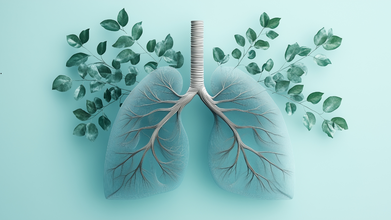- Health Conditions A-Z
- Health & Wellness
- Nutrition
- Fitness
- Health News
- Ayurveda
- Videos
- Medicine A-Z
- Parenting
UK Presents Bill To Allow 'Assisted Dying': What It Means And How Is It Different From Euthanasia

Assisted Dying (Credit: Canva)
Terminally ill people in England and Wales could have the right to choose to end their life—a practice that is already legal in a few countries. Earlier this month, Labour MP Kim Leadbeater introduced the Terminally Ill Adults (End of Life) Bill, which was voted upon recently. A separate but similar bill is under discussion in Scotland.
What Is Assisted Dying?
Put in simple terms, it refers to the practice of ending a person's life through medication—either self-administered or by a medical professional. Assisted death is legal in at least 11 states across the US along with a handful of other countries like Canada and Belgium. It is important to note that assisted dying includes both assisted suicide and euthanasia.Assisted suicide is intentionally helping another person to end their life, which may not even require a terminal diagnosis but again it depends from place to place and condition to condition. That could involve providing lethal medication or helping them travel to another jurisdiction to die. However, the bill presented in UK clearly states that it will be used only for patients who are terminally ill and have less than 6 months to live.
How Is It Different From Euthanasia?
Euthanasia—also referred to mercy killing—is the practice of intentionally ending a life to relieve pain and suffering. The legality of this practice varies across the globe, with a small number of countries permitting it under strict conditions. The list include Belgium, Australia, Canada, Colombia, Ecuador, Luxemburg, The Netherlands, New Zealand, Portugal and Spain.
At present, laws throughout the British territory prevent people from asking for medical help to die. However, the bill could change it. Here are the requirements of the proposed bill:
Anyone who wishes to end their lives, must be over 18 and live in England and Wales, and have been registered with a GP for at least 12 months
They must have the mental capacity to make the choice and be deemed to have expressed a clear, settled and informed wish, free from coercion or pressure
They will be expected to die within six months
Also, they need to make two separate declarations, witnessed and signed, about their wish to die
Finally, they need to satisfy two independent doctors that they are eligible - with at least seven days between each doctors' assessment
Moreover, a High Court judge must hear from at least one of the doctors, and can question the dying person, or anyone else considered relevant. After the judge has made their ruling, a patient would have to wait another 14 days before acting. Notably, it is completely illegal to pressurize someone to take their own lives. Anyone found to do could risk a 14-year prison sentence.
The bill is also facing considerable opposition. Opponents reportedly argue that legalizing assisted suicide could pressure vulnerable individuals into ending their lives. They urge the government to prioritize enhancing palliative care instead. Among those opposing the change is Paralympian and House of Lords crossbencher Baroness Grey-Thompson, who has voiced concerns over the potential risks of altering the law on assisted death.
Is It Different in Scotland?
Yes, the bill is slightly different in Scotland. A person calling for assisted suicide must be a resident of the country for at least 12 months. Additionally, they should be registered with a GP in Scotland, be terminally ill and must have the mental capacity to make the request.
The Kessler Twins Die By Assisted Suicide in Germany; How It Differs From Euthanasia

Credits: Wikimedia Commons and Instagram
The two legendary German twins, Alice and Ellen Kessler, the greatest of entertainers, who rose to fame in the post war era died at the age of 89. They truly were inseparable, as they chose to leave the world in the same way they came, together. The sisters chose medically assisted dying on November 17, as reported by the German newspaper Bild.
The twin had shared that they "no longer wanted to live" and the decision to die together was made together with clarity and intention.
How Does Assisted Dying Work?
In terms of the Kessler Sisters, the police confirmed that there were no signs of foul play. The German Society for Humane Dying also stated that the sisters had chosen assisted suicide. This practice is legal in the country since 2019.
Read: Uruguay Becomes The First Catholic Latin American Country To Legalize Euthanasia
How Is Assisted Dying Different Than Euthanasia?
In assisting dying, the law allows and enables the individuals to self-administer the medication, so the choice and the agency to die remains with the individuals.
What Is Assisted Dying?
This refers to the practice of ending a person's life through medication. However, when the term 'dying' is replaced by 'suicide', the medication is then administered by self, whereas in other procedures, it may be done by a medical professional. Thus the term 'assisted dying' refers to both assisted suicide and euthanasia.
In assisted suicide, the person's will to die matters, and it may not require a terminal diagnosis. However, this definition to varies from country to country.
Also Read: Can Right To Die Be Practiced By Non-Terminally Ill Patients?
In many ways can assisted suicide be practiced including providing lethal medication, or helping the individual travel to another jurisdiction to die.
What Does The Law In Germany Say About Assisted Suicide?
In 2020, Germany's Federal Constitutional Court determined that individual autonomy should include the choice to die. This means that every person could decide for themselves. The law has a wider scope, which also includes any person helping an individual who has chosen to end their life, and they cannot be penalized for doing so. However, this condition only comes from the person who wants to end their life, and the decision must be taken freely.
The debate was introduced in 2015 due to the section 271 of the criminal code, which made assisted suicide almost impossible in Germany. The law stated that anyone who aided someone to take their own life could be jailed for up to three years.
Palliative sedation is administered to prevent suffering and ensure a dignified death. However, medication aims to relieve patients of unbearable pain, this is why its use as an alternative medically assisted suicide raises concerns. Currently, there is no approved medication for medically assisted suicide in Germany. though several medications are could be used, for instance in the United States, severely ill patients receive high doses of sodium pentobarbital and thiopental. However, pentobarbital is only approved for veterinary use in Germany.
In Germany, the intravenous route is often chosen, where the medication is administered through IV, and the patient must be the one opening the infusion. Doctors can assist but should not be directly involved in the act.
World COPD Day 2025: Theme, History, Significance

Credits: Canva
Every year on November 19, World COPD Day is organized to raise awareness, share knowledge and discuss ways to reduce the burden of COPD worldwide. COPD stands for Chronic Obstructive Pulmonary Disease, and as per the World Health Organization (WHO), it is the fourth leading cause of death worldwide and has caused 3.5 million deaths in 2021 alone, of the 213 million people who were diagnosed with it. Projections indicate that the number of cases will increase to nearly 600 million by 2050, with a disproportionate rise expected among women and in low-and middle-income countries.
World COPD Day 2025 Theme
The theme for World COPD Day 2025 is 'Short of Breath, Think COPD'.
This year’s theme highlights a crucial issue: despite being the third leading cause of death globally, COPD is still widely overlooked and often misdiagnosed. Although it is a common, preventable, and treatable condition, many patients either remain undiagnosed or receive the wrong treatment. Early and accurate diagnosis can make a major public health difference, leading to better symptom control, improved lung function, and a higher quality of life.
Doctors stress that COPD should be suspected in anyone with persistent breathlessness, chronic cough, sputum production, recurrent lower respiratory infections, or a history of exposure to risk factors such as tobacco smoke, indoor cooking fuels, or occupational pollutants.
World COPD Day Origin
World COPD Day was launched in 2002 by the Global Initiative for Chronic Obstructive Lung Disease (GOLD) in partnership with the WHO. The first event marked a turning point in global respiratory health awareness, encouraging collaboration across continents.
Importance Of World COPD Day
The importance lies in its ability to draw attention to one of the top causes of deaths worldwide. Furthermore, this day promotes awareness by educating the public about COPD symptoms, persistent cough, breathlessness, and chest tightness, which may be mistaken as symptoms of normal aging.
It also encourages prevention of COPD, especially by emphasizing on quitting smoking, improving air quality, and reducing workplace exposures that contribute to COPD.
It also helps in the improvement of healthcare access, supports research and innovation by encouraging collaborations, and reduces stigma by helping patients overcome psychological barrier and seek timely help.
What Is COPD?
As per NHS UK, it is the name for a group of lung conditions that cause breathing difficulties. It includes:
- emphysema – damage to the air sacs in the lungs
- chronic bronchitis – long-term inflammation of the airways
COPD is a common condition that mainly affects middle-aged or older adults who smoke. Many people do not realize they have it.
The breathing problems tend to get gradually worse over time and can limit your normal activities, although treatment can help keep the condition under control.
Common Symptoms of COPD
- shortness of breath, particularly when you're active
- a persistent chesty cough with phlegm – some people may dismiss this as just a "smoker's cough"
- frequent chest infections
- persistent wheezing
Chris Hemsworth's Father Has Alzheimer’s, and Tests Show He Carries the Risk Gene Too

Credits: NatGeo/Chris Hemsworth Instagram
Talking about things makes you feel better, and the Thor star Chris Hemsworth is right at it. Now 42, he is opening up about his father, Craig's diagnosis of Alzheimer's and have seen the corrosive effects on his memory and perception already. He is now making the best of it, by having it all documented on film. While he was in the middle of making National Geographic longevity series Limitless, he learned that he too carried two copies of the Alzheimer's signifying gene APOE4, one from each parent. Back then he confronted this on camera, while on shoot, and this feels like a great idea for him to do it again on A Road Trip To Remember, an hour-long documentary that will air on NatGeo.
“There was apprehension about how this would be portrayed,” Hemsworth admits. “I asked Dad what he felt, and he was actually enthusiastic. He wanted to do it.”
The Australian actor is now taking steps to stay mentally and physically fit, especially after knowing that he is predisposed for Alzheimer's disease.
Living With More Awareness Now
Chris, who shares three children with wife Elsa Pataky, says his father's struggles have made him reflect deeply on how he lives. Some hardships in life, he notes, simply can’t be avoided.
“For me, the biggest takeaway was the comfort crisis we face,” he says, as reported in Esquire. “We settle for what’s familiar, even when it’s wrong, because the unknown feels scarier. But pushing against that is where growth happens.”
His father’s reaction to the diagnosis has also taught him that even a grim prognosis can be approached with courage. “It causes fear, but it’s also a reminder not to take anything for granted,” Hemsworth says. “While he can, Dad wants to capture as many memories as possible.”
A Trip Down The Memory Lane
At the time of filming, Craig’s symptoms were sporadic—some memory lapses, moments of confusion, but overall lucidity remained. Alzheimer’s, however, does not improve with time. Knowing this, the father-son duo set out on a cross-country motorbike trip across Australia.
They retraced old memories:
- A house in Melbourne where the family lived in the early ’90s
- A Northern Territory ranch where Craig once wrangled bulls
- A specific bend in an Outback creek where the family played when the boys—Chris, Luke, and Liam—were small
Guided only by a fading photograph and half-recalled memories, they attempted to reconnect with moments that shaped their family’s early years.
The documentary also explores reminiscence therapy, guided by Dr. Suraj Samtani from the Centre for Healthy Brain Ageing at the University of Sydney. The technique uses personal memories, photos, and familiar environments to stimulate the hippocampus, the part of the brain most affected by Alzheimer’s.
“One-on-one time with Dad was special,” Chris says. “Growing up, it was always all of us together.”
For Hemsworth, the experience has made one truth clear: the importance of connection.
“It became less about the science and more about the moments together,” he says. “Whether it’s 20 years or 20 days, hold on to every moment. Connect deeply, as often as you can.”
© 2024 Bennett, Coleman & Company Limited

